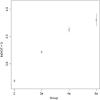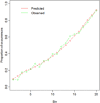Factors determining the smooth flow and the non-operative time in a one-induction room to one-operating room setting
- PMID: 25496600
- PMCID: PMC4406160
- DOI: 10.1111/jep.12288
Factors determining the smooth flow and the non-operative time in a one-induction room to one-operating room setting
Abstract
Rationale, aims and objectives: What factors determine the use of an anaesthesia preparation room and shorten non-operative time?
Methods: A logistic regression is applied to 18 751 surgery records from AZ Sint-Jan Brugge AV, Belgium, where each operating room has its own anaesthesia preparation room. Surgeries, in which the patient's induction has already started when the preceding patient's surgery has ended, belong to a first group where the preparation room is used as an induction room. Surgeries not fulfilling this property belong to a second group. A logistic regression model tries to predict the probability that a surgery will be classified into a specific group. Non-operative time is calculated as the time between end of the previous surgery and incision of the next surgery. A log-linear regression of this non-operative time is performed.
Results: It was found that switches in surgeons, being a non-elective surgery as well as the previous surgery being non-elective, increase the probability of being classified into the second group. Only a few surgery types, anaesthesiologists and operating rooms can be found exclusively in one of the two groups. Analysis of variance demonstrates that the first group has significantly lower non-operative times. Switches in surgeons, anaesthesiologists and longer scheduled durations of the previous surgery increases the non-operative time. A switch in both surgeon and anaesthesiologist strengthens this negative effect. Only a few operating rooms and surgery types influence the non-operative time.
Conclusion: The use of the anaesthesia preparation room shortens the non-operative time and is determined by several human and structural factors.
Keywords: anaesthesia induction room; non-operative time; operating room management; operating room scheduling; parallel flow in a surgery line.
© 2014 The Authors. Journal of Evaluation in Clinical Practice published by John Wiley & Sons, Ltd.
Figures





Similar articles
-
Modeling procedure and surgical times for current procedural terminology-anesthesia-surgeon combinations and evaluation in terms of case-duration prediction and operating room efficiency: a multicenter study.Anesth Analg. 2009 Oct;109(4):1232-45. doi: 10.1213/ANE.0b013e3181b5de07. Anesth Analg. 2009. PMID: 19762753
-
Operating room start times and turnover times in a university hospital.J Clin Anesth. 1994 Sep-Oct;6(5):405-8. doi: 10.1016/s0952-8180(05)80011-x. J Clin Anesth. 1994. PMID: 7986513
-
Analysis of efficiency of common otolaryngology operations: comparison of operating room vs short procedure room in a pediatric tertiary hospital.Arch Otolaryngol Head Neck Surg. 2003 Apr;129(4):435-7. doi: 10.1001/archotol.129.4.435. Arch Otolaryngol Head Neck Surg. 2003. PMID: 12707191
-
Optimizing Operating Room Scheduling.Anesthesiol Clin. 2015 Dec;33(4):697-711. doi: 10.1016/j.anclin.2015.07.006. Anesthesiol Clin. 2015. PMID: 26610624 Review.
-
[Do we need a surgical safety checklist?].J Gynecol Obstet Biol Reprod (Paris). 2010 Sep;39(5):362-70. doi: 10.1016/j.jgyn.2010.01.007. Epub 2010 May 13. J Gynecol Obstet Biol Reprod (Paris). 2010. PMID: 20471185 Review. French.
Cited by
-
Operating room efficiency after the implementation of MAKO robotic-assisted total knee arthroplasty.Arch Orthop Trauma Surg. 2023 Sep;143(9):5501-5506. doi: 10.1007/s00402-023-04834-w. Epub 2023 Mar 21. Arch Orthop Trauma Surg. 2023. PMID: 36943503
References
-
- Cardoen B, Demeulemeester E, Beliën J. Operating room planning and scheduling: a literature review. European Journal of Operational Research. 2010;201(3):921–932.
-
- Macario A, Vitez TS, Dunn B, McDonald T. Where are the costs in perioperative care?: analysis of hospital costs and charges for inpatient surgical care. Anesthesiology. 1995;83(6):1138–1144. - PubMed
-
- Healthcare Financial Management. Achieving operating room efficiency through process integration. Healthcare Financial Management: Journal of the Healthcare Financial Management Association. 2003;57(3) Suppl. 1–7:112. - PubMed
-
- Hopp W, Spearman M. Factory Physics. New York: McGraw-Hill; 2008.
-
- Beliën J, De Boeck L, Colpaert J. Managing variability in manufacturing and services. Review of Business and Economic Literature. 2012;57(3):302–315.
MeSH terms
LinkOut - more resources
Full Text Sources
Other Literature Sources
Medical

